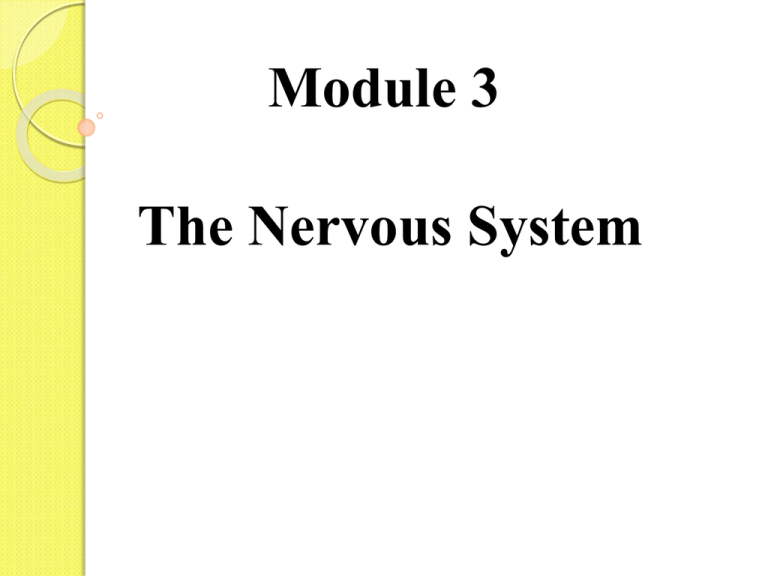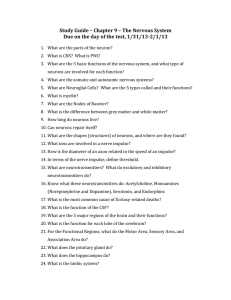Nervous System - Gordon State College
advertisement

Module 3 The Nervous System Nerve Tissue ◦ Nerve tissue throughout the body is composed of two types of cells: Neurons Supporting glial cells The Neuron Neurons are specialized cells in the nervous system that send and receive information throughout the body. ◦ Neurons are the nervous system’s building blocks. The Neuron The nervous system contains 90 to 180 billion neurons (98.8 percent in the brain and 1.2 percent in the spinal cord). ◦ Each neuron transmits information to about a thousand other neurons; there are trillions of different neural connections in the brain. The Neuron: Three Basic Parts Soma: central part of neuron (Latin word for “body”) Dendrites: branchlike extensions attached to the soma that receive information from other neurons Axon: a tubelike extension of the soma that sends information in the form of an electrochemical impulse Structure of a Neuron Three Basic Types of Neurons ◦ Sensory neurons: send information from sensory receptors to the brain ◦ Motor neurons: send commands from the brain to glands, muscles, and organs ◦ Interneurons: connect other neurons to one another Neural Communication Action Potential ◦ a neural impulse; a brief electrical charge that travels down an axon ◦ generated by the movement of positively charged atoms in and out of channels in the axon’s membrane Neural Communication Threshold ◦ the level of stimulation required to trigger a neural impulse ◦ Firing is all or none ◦ Neurons differ in their potential speed of firing (2 – 270 mph). Structure and Operation of the Neuron Synapses: Points of Chemical Transmission between Neurons ◦ Axon terminal buttons contain round sacs called synaptic vesicles. ◦ When an action potential arrives, it causes these vesicles to release chemical messengers, called neurotransmitters, which travel across the synaptic cleft. ◦ These neurotransmitters fit into the receiving dendrites’ receptor sites, like keys fit into locks. Synaptic Transmission Synaptic Transmission—Reuptake Synaptic Transmission— Enzyme Deactivation Synapses: Chemical Transmission between Neurons After locking into receptor sites, neurotransmitters either excite or inhibit firing of the receiving neuron. Excitatory messages increase the probability of an action potential. Inhibitory messages reduce the likelihood of neural firing. Whether the neuron fires will depend on which type of message is in greater abundance. Synapses: Chemical Transmission between Neurons After neurotransmitters deliver their messages they are either: ◦ Repackaged into new synaptic vesicles in a process known as reuptake or ◦ Broken down by enzymes and removed from the synaptic cleft in a process called enzyme deactivation. Chemical Neurotransmitters About 75 neurotransmitters have been identified, including: Acetylcholine (ACh): involved in muscle contraction, cognition, and memory formation Dopamine (DA): controls large muscle movements; influences pleasure and motivation Chemical Neurotransmitters About 75 neurotransmitters have been identified, including: Endorphins: important in the experience of pleasure and control of pain Serotonin: involved in regulating emotional states such as depression, sleep cycles and dreaming, aggression, and appetite Agonists and Antagonists Neurotransmitter molecule Receptor site on receiving neuron Receiving cell membrane Agonist mimics neurotransmitter Antagonist blocks neurotransmitte Psychoactive Drug Use Psychoactive drugs: ◦ chemicals that modify mental processes, behavior, mood, and/or perception) ◦ are often used to deliberately alter consciousness ◦ work at synapses to block or stimulate neural activity. Effects of Cocaine on Neurotransmitters Drugs and Consciousness Drug rebound ◦ Returning to a “higher” or “lower” state than normal following the use of a drug Drug Tolerance Drug effect Tolerance ◦ diminishing effect with regular use of the same dose of a drug Response to first exposure After repeated exposure, more drug is needed to produce same effect Drug dose Withdrawal ◦ discomfort and distress that follow discontinued use of an addictive drug Drugs and Consciousness Physical Dependence ◦ a physiological need for a drug ◦ marked by unpleasant withdrawal symptoms Psychological Dependence ◦ a psychological need to use a drug ◦ for example, to relieve negative emotions Psychoactive Drug Use Common Drug Effects rebound: returning to a state different from normal when the drug has “worn off” tolerance: requiring greater amounts of a drug to produce the same effect withdrawal: unpleasant to life-threatening physical reactions to the absence of a drug in the body addiction: felt physical and/or psychological need to continue use of a drug Psychoactive Drugs Depressants ◦ Opiates Stimulants Psychedelics/hallucinogens Depressants a class of psychoactive drugs that slow down—or depress—the nervous system and decrease mental and physical activity Alcohol: the most widely consumed and abused depressant Sedatives/ tranquilizers: Mild doses produce relaxation, mild euphoria, and reduced inhibitions. The opiates (narcotics): include opium, morphine, and heroin; reduce pain Stimulants Psychoactive drugs that speed up—or stimulate—the nervous system and increase mental and physical activity. ◦ Caffeine and nicotine ◦ Cocaine and amphetamines Cocaine activates the sympathetic nervous system Amphetamines: activate the sympathetic nervous system; increase dopamine and norepinephrine activity. ◦ Ecstasy and Ritalin Ecstasy or MDMA: affects the brain cells that produce serotonin Ritalin: decreases distractibility and improves concentration Hallucinogens psychoactive drugs that distort perception and generate sensory images without any external stimulation ◦ ◦ ◦ ◦ ◦ LSD PCP Mescaline Psilocybin marijuana Hallucinogens LSD (lysergic acid diethylamide): ◦ Synthesized ◦ Chemically similar to serotonin ◦ Binds with serotonin brain receptors (agonist) associated with dreaming ◦ Principal effects involve hallucinations & perceptual distortions ◦ Causes users to experience a dreamlike state of mind while they are awake. Hallucinogens Users of LSD may also experience: Synesthesia: a blending of sensory experiences Subjective time alteration Flashbacks: recurrences of the drug’s effects without the drug (occur in more than 15 percent of LSD users and can persist for months following the drug experience) There is no way to predict how a person will react to the drug. Marijuana From the hemp, or Cannabis, plant The major psychoactive ingredient is THC, organic molecule delta-9 tetrahydrocannabinol. Users often experience: An increased sense of well-being/relaxation, Spontaneous laughter, A heightened sensitivity to various stimuli, A distortion of time, and A disconnected flow of ideas. ◦ Consistent high quantity use of marijuana may have negative effects on motivation and interpersonal skills. Psychoactive Drugs Drug Type Pleasurable Effects Adverse Effects Alcohol Depressant Initial high followed by relaxation and disinhibition Depression, memory loss, organ damage, impaired reactions Heroin Depressant Rush of euphoria, relief from pain Depressed physiology, agonizing withdrawal Caffeine Stimulant Increased alertness and wakefulness Anxiety, restlessness, and insomnia in high doses; uncomfortable withdrawal Metham- Stimulant phetamine Euphoria, alertness, energy Irritability, insomnia, hypertension, seizures Cocaine Stimulant Rush of euphoria, confidence, energy crash Cardiovascular stress, suspiciousness, depressive Nicotine Stimulant Arousal and relaxation, sense Heart disease, cancer (from of well-being tars) Marijuana Mild Enhanced sensation, pain relief Lowered sex hormones, hallucinogen disrupted memory, distortion of lung damage from smoke time, relaxation Neural and Hormonal Systems The nervous system is the body’s primary information system and is divided into two major portions: ◦ Central nervous system ◦ Peripheral nervous system Neural and Hormonal Systems Nerves ◦ neural “cables” containing many axons ◦ part of the peripheral nervous system ◦ connect the central nervous system with muscles, glands, and sense organs Nervous System Central Nervous System (CNS) ◦ the brain and spinal cord Peripheral Nervous System (PNS) ◦ the sensory and motor neurons that connect the central nervous system (CNS) to the rest of the body The Peripheral Nervous System Peripheral nervous system: All the nerves located outside the brain and spinal cord. ◦ Its function—to connect the brain and spinal cord with the organs and tissues of the body. ◦ The peripheral nervous system is composed of two major divisions: The somatic/skeletal nervous system The autonomic nervous system Sympathetic nervous system Parasympathetic nervous system Spinal Cord: Connects the Peripheral Nervous System to the Brain Central nervous system (CNS): brain and spinal cord ◦ Spinal cord: slender, tube-shaped part of the (CNS) that connects the brain to the body via the peripheral nervous system The spinal cord transmits information from sensory neurons to the brain, and from the brain to motor neurons that initiate movement. The upper segments of the spinal cord control the upper parts of the body, while the lower segments control the lower body. The spinal cord also controls some automatic, involuntary responses to sensory stimuli called reflexes. Reflex: a simple, automatic, inborn response Brain Sensory neuron (incoming information) Muscle Interneuron Spinal cord Neural and Hormonal Systems Nervous system Central (brain and spinal cord) Peripheral Autonomic (controls self-regulated action of internal organs and glands) Skeletal (controls voluntary movements of skeletal muscles) Sympathetic (arousing) Parasympathetic (calming) The Endocrine System Communicates by Secreting Hormones The endocrine system is interconnected with—but not part of—the nervous system. ◦ consists of a network of glands that make and secrete hormones - chemical messengers. ◦ The pituitary gland, in the base of the brain, releases about 10 different hormones and is controlled by the hypothalamus. ◦ Other endocrine glands include the thyroid gland, the adrenal glands, and the gonads.






